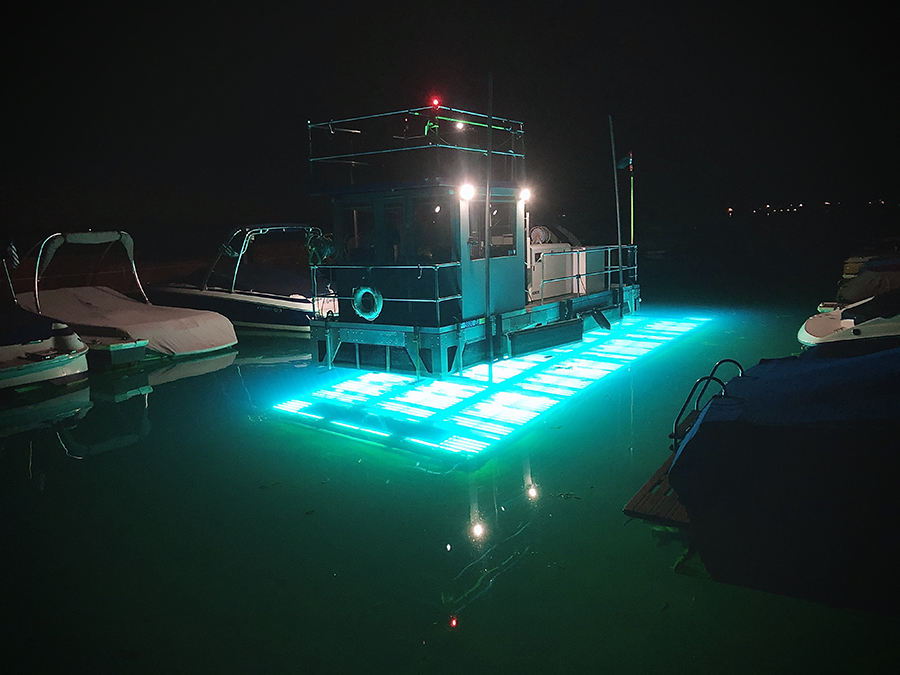Vessel equipped with UV attacks invasive aquatic plants at Tahoe PPP
Published on by Water Network Research, Official research team of The Water Network in Technology
A partnership between the University, TRPA and IRI corporation is working on a solution to control invasive aquatic plants at Lake Tahoe.

A new control tool for aquatic invasive plants that clog waterways, reduce water clarity and provide cover for other invasive species at Lake Tahoe continues to show impressive results in its third year of testing. The tool is a light array mounted under a working barge, which trolls through the marina dousing the plants on the lake bottom with ultraviolet-C light.
The technology, using the UV-C wavelengths of light to kill the plants, in this case Eurasian watermilfoil and curlyleaf pondweed, was developed by John J. Paoluccio, president of Inventive Resources, Inc. Aquatic invasive plants are one of the greatest threats to Tahoe’s clarity, ecology and recreation-based economy. The pilot project showed that applying the light treatment caused invasive plants to deteriorate or completely collapse within seven to 14 days of treatment.
The UV-C light is a short-wave electromagnetic radiation light that damages the DNA and cellular structure of aquatic plants and their fragments.
“The demonstration project of UV light application technology is implementing additional trials at larger scales at the Lakeside Marina at Tahoe’s south shore,” Dennis Zabaglo, manager of the Aquatic Resources Program at Tahoe Regional Planning Agency, said. “This exciting, innovative approach is one of the main methods being considered in combination with other technologies to control weeds in the Tahoe Keys, which comprise the biggest aquatic weed infestation in Lake Tahoe.”
Aquatic plants have invaded multiple marinas and nearshore areas of the lake creating habitat for other invasive species like bass and bluegill. Aquatic invasive species compete with native species and can increase algae growth that contributes to the decline of Lake Tahoe’s water clarity. Thick aquatic plant growth hinders navigation and can tangle on rudders, hulls and paddles.
Testing on a larger scale
Lakeside Marina and beach is one of the sites where this technology is being tested on a larger scale. Researchers from the University of Nevada, Reno's College of Science are monitoring the project and collecting data to study the effects of the UV light treatments.
"Initial reports from the field and laboratory testing look very good," said Sudeep Chandra, director of the University’s Global Water Center. "Depending on the plant species, our divers are observing a reduction in the plant height and change in the structure of invasive aquatic plants after they have been treated with ultraviolet light. This could be a game changer for managing plants at a larger scale at Lake Tahoe or beyond."
The University will quantify the dynamics of plant growth for another year and evaluate the effectiveness of ultraviolet light and other tools that can be used to develop a weed control strategy for the larger lake.
"Similar to cancer treatment or treating a virus, we want to fine-tune the application of UV under varying water quality conditions found within the lake and exposing plants under their different life stages,” Chandra said. “Fortunately, for our team, our partners at Inventive Resources, the Tahoe Resource Conservation District and the Tahoe Regional Planning Agency continue to work hand-in-hand to develop new tools for reducing the infestation of invasive species at Lake Tahoe or preventing new introductions to the lake."
“Last year, we treated the entire Lakeside Beach two times,” Paoluccio said. “Each week we took underwater photographs at the beach, and now do not see as many tall plants compared to years past. This is our first year of complete UV treatment in the marina. During the first phase of treatment we worked along the docks and in the open areas between the boats slips. Not much survived the first treatment.”
IRI tested their third generation vessel at Lakeside Marina and, so far, there is a clear difference of where treatment occurred and where there was no treatment. The boat is now outfitted with a larger 12-foot x 32-foot UV array, which can cantilever under boats and slips to minimize marina disruptions.
“Next year we plan to make the array even larger,” Paoluccio said. “The eventual goal is to have multiple arrays coupled together so one crew could treat an acre a day. This way we could easily treat two to three times a year to prevent the plants growing to maturity. Timing, temperature and water quality all play a role. Large infestations that have taken months to grow can be treated in a matter of days, reducing plant populations after each consecutive treatment.”
University partners with private company and public agencies
This project is a private-public partnership between the University of Nevada, Reno, Inventive Resources Inc. and TRPA through the Environmental Improvement Program. Findings from this collaboration will be presented to the Lake Tahoe Aquatic Invasive Species Coordinating Committee to enhance the partnership’s strategy to control invasive aquatic weeds.
The Lake Tahoe Aquatic Invasive Species Program, part of the Watersheds and Water Quality focus area of the EIP, is implemented by 40 public and private partner organizations, including federal, state, and local jurisdictions, research partners, public utility districts, and private marinas. The Tahoe Regional Planning Agency and the Tahoe Resource Conservation District lead the program in collaboration with the public and private partners. The program’s mission is to prevent, detect, and control aquatic invasive species in the Region so that future generations can enjoy Lake Tahoe.
According to the U.S. Department of Agriculture, aquatic invasive plants can be a major problem in freshwater and marine systems, changing the function of ecosystems and causing a nuisance for boaters. Using ultraviolet light could be a promising tool for managers across the United States, from California to Gulf Stream waters.
The UV Vessel rids the beach and swimming area of 8-10 foot high invasive plants.
Science & Health | August 12, 2020
Taxonomy
- Algaecides
- Algae
- Algae Treatment
- Algal Blooms